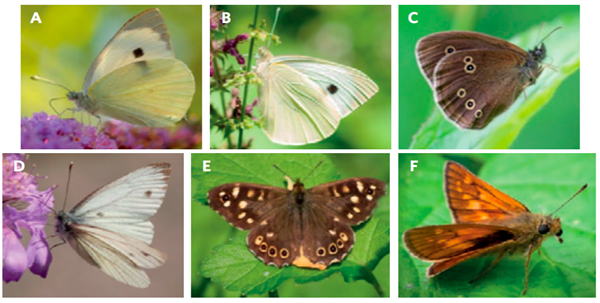Robert McSweeney
10.08.2015 | 4:00pmFrequent droughts and habitat loss could push drought-sensitive butterflies in the UK to local extinction by the middle of the century, new research suggests.
Even in a very optimistic scenario, where habitat is improved, the likelihood of these butterflies surviving climate change drops to zero by 2100, if emissions stay very high.
The “alarming” results highlight the need to limit climate change by capping emissions, the lead author tells Carbon Brief.
Very hungry caterpillars
In the summer of 1995, the UK experienced an exceptionally dry summer, the most arid since records began in 1776. Among the impacts of the hot, dry season, the population of several species of butterfly collapsed, says Dr Tom Oliver, a researcher at the UK’s Centre for Ecology and Hydrology.
Heatwaves and droughts affect adult butterflies, says Oliver, but caterpillars are even more sensitive to extreme weather, he explains to Carbon Brief:
Populations of some species of butterfly took several years to recover to normal levels, says Oliver.
With droughts likely to become more frequent as the climate warms, Oliver set about testing what effect this could have on butterfly numbers. Looking at data from the UK Butterfly Monitoring Service (UKBMS), they identified six species that tend to suffer a fall in number after dry years and suffered a major drop after the 1995 drought.

The six species of butterfly considered in the study: a) Cabbage white, b) Small cabbage white, c) Ringlet, d) Green veined white, e) Speckled wood, and f) Large skipper. Source: Oliver et al. (2015).
The results of the study, published in Nature Climate Change, suggest that rising temperatures and fragmented habitats could mean we lose entire species of butterfly by the middle of the century.
Recovery time
With global temperature as it is today, we wouldn’t expect another drought as severe as 1995 for more than 200 years. But climate change will drastically cut this return time in the future, the researchers say.
Even if global temperature rise is held at 2C above pre-industrial levels – that’s 1.15C above the warming we’ve already seen to date – we could still expect to see a drought as serious as 1995 every six years. On the other hand, if emissions stay very high, a severe drought could be expected almost every year.
In the charts from the paper below, you can see how aridity – a measure of dryness – is projected to increase in England through the century. The bigger the increase in aridity, the more likely it is for a drought to occur. The dashed line shows the year 1995 for comparison.

Observed and projected changes in annual aridity for central England under four different Representative Concentration Pathways (RCP) emissions scenarios from 17 global climate models: from the lowest emissions (RCP2.6, top-left) and RCP4.5 (top-right), through to RCP6.0 (bottom-left), and the highest scenario (RCP8.5, bottom-right). Average aridity shown as the coloured lines, and the dashed line indicated the aridity in 1995. Source: Oliver et al. (2015) Supplementary information.
With droughts coming as often as every few years, butterflies wouldn’t be able to recover in between, Oliver says:
Fragmented habitats
Butterflies like to live in what are called semi-natural habitats, says Oliver:
But buildings, roads and other developments can eat into, or fragment, this habitat, which also affects butterfly numbers, Oliver says:
After the 1995 drought, butterflies in fragmented habitats were the worst affected and the slowest to recover, the study notes.
To look at how the added impact of habitat change might affect their projections, the authors incorporated potential future changes in habitat into their analysis. They factored in the total area of habitat and how fragmented it becomes, based on possible land-use changes around butterfly monitoring sites.
As the red line in the top-left chart below shows, even with the most optimistic projections where habitat is widely available, drought-sensitive butterfly populations wouldn’t survive climate change if emissions remain very high. And with more fragmented habitats, as in the middle two charts, they could be extinct by 2050.
Under low emissions and plentiful habitat (blue line in the top-left chart), the butterflies have about a 50:50 chance of survival through the century, the paper says.

Percentage of models where climatic conditions allow the six butterfly species to survive through the 21st century, for scenarios RCP2.6 (blue lines) and RCP8.5 (red), with RCP4.5 (orange) and RCP6.0 (black) shown in right-hand bars. Charts show different habitat conditions: a) High area & low fragmentation, b) Low area & low fragmentation, c) High area & high fragmentation, d) low area & high fragmentation, and e) current habitat. Source: Oliver et al. (2015).
Essential functions
Oliver says it’s unlikely that the drought-prone butterflies will evolve sufficiently to cope with increasingly dry conditions:
Despite the gloomy projections, there is some room for optimism, says Oliver:
But for improved habitat to help ensure the survival of these drought-sensitive butterflies, it must be combined with major emissions reductions, the paper concludes.
Though the study focuses on vulnerable butterfly species, the results could provide a warning about the survival of other insects, Oliver says:
And these species offer a lot more than just being nice to look at as they flutter or buzz around our gardens, says Oliver:
Oliver, T.H. et al. (2015) Interacting effects of climate change and habitat fragmentation on drought-sensitive butterflies, Nature Climate Change, doi:10.1038/nclimate2746
-
Frequent droughts and habitat loss could push drought-sensitive butterflies in the UK to local extinction by the middle of the century


